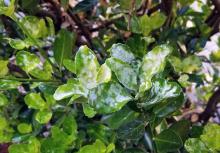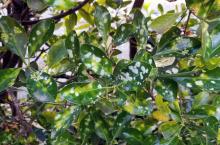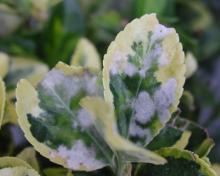Cause Erysiphe euonymicola (formerly Oidium euonymi-japonici), a fungus that occurs only on Euonymus japonica and is found wherever the host grows. The green cultivar Patens is very susceptible. In the past, the fungus was rarely observed on variegated cultivars but now is much more common. The fungus overwinters as mycelia and spores on infected leaves and stems. Airborne spores are spread to newly emerging leaves in the spring. Infection is favored by temperatures of 70°F to 80°F and relative humidity between 85% and 100%. Free water on leaf surfaces will often suppress spore germination.
Symptoms The disease first appears on leaves and tender stems as small, scattered white patches. These are generally first seen on the new growth. A thick felt-like mat forms on both sides of leaves, causing some yellowing and defoliation.
Cultural control
- Water forcibly sprayed on both sides of leaves under fast-drying conditions.
- Remove and destroy heavily infected plant parts.
- Improve air circulation and reduce humidity around plants.
Chemical control Fungicides will do best when used before symptoms develop. Few materials have good eradicant activity. Use at 7- to 14-day intervals; using shorter intervals when environmental conditions favor disease development. Alternate or tank-mix products from different groups that have different modes of action. Limit the use of any one group during the growing season.
- Armada 50 WDG at 3 to 9 oz/100 gal water. Do not use a silicone-based surfactant. Not for nursery or greenhouse use. Group 3 + 11 fungicide. 12-hr reentry.
- Avelyo at 3 to 5 fl oz/100 gal water. Group 3 fungicide. 12-hr reentry.
- Banner MAXX at 5 to 8 fl oz/100 gal water may be effective. Group 3 fungicide. 12-hr reentry.
- Bicarbonate-based products. Might be used to supplement a normal program when powdery mildew is first observed. Do not mix with acidifying agents. Thorough coverage is essential. Addition of a surfactant will be helpful. O
- MilStop (85% potassium bicarbonate) at 2.5 to 5 lb/A. Oregon and Washington only. 1-hr reentry.
- Monterey Bi-Carb Old Fashioned Fungicide at 4 teaspoons/2 gal water. H
- Broadform at 2 to 4 fl oz/100 gal water. Group 7 + 11 fungicide. 12-hr reentry.
- Compass 50 WDG at 1 to 2 oz/100 gal water. Do not use organosilicate additives. Group 11 fungicide. 12-hr reentry.
- Eagle 20 EW at 6 to 12 fl oz/100 gal water. Group 3 fungicide. 24-hr reentry.
- Heritage at 1 to 4 oz/100 gal water plus a non-silicone-based wetter sticker. Group 11 fungicide. 4-hr reentry.
- Myclobutanil 20 EW T&O at 6 to 12 fl oz/100 gal water plus spreading agent. May observe a PGR effect. Group 3 fungicide. 24-hr reentry.
- Orkestra at 6 to 8 fl oz/100 gal water. Group 7 + 11 fungicide. 12-hr reentry.
- Pageant at 6 to 12 oz/100 gal water. Do not use on Euonymus vegetus as injury may occur. Do not use with organosilicone-based adjuvants. Group 7 + 11 fungicide. 12-hr reentry.
- Seido at 4 to 5 fl oz/100 gal water plus an adjuvant. Group 50 fungicide. 4-hr reentry.
- Spectracide Immunox Multi-Purpose Fungicide Spray Concentrate for Gardens at 1 fl oz/gal water. Group 3 fungicide. H
- Terraguard SC at 4 to 8 fl oz/100 gal water. Group 3 fungicide. 12-hr reentry.
- Tourney EZ at 1 to 4 oz/100 gal water. Group 3 fungicide. 12-hr reentry.
- Trinity at 4 to 12 fl oz/100 gal water. Group 3 fungicide. 12-hr reentry.
Note Do not use Insignia or Pageant on Euonymus vegetus as injury may occur.
References Horst, R.K. 2013. Westcott's Plant Disease Handbook, 8th ed. Netherlands: Springer Science+Business Media.
Ziv, O., and Hagiladi, A. 1993. Controlling powdery mildew in euonymus with polymer coatings and bicarbonate solutions. HortScience 28:124-126.




